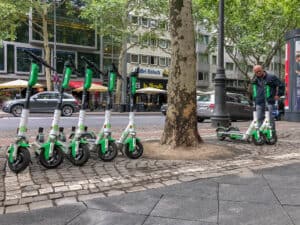
“Rentable E-scooter by Lime at the roadside in Cologne to move car-free through the city”by verchmarco is licensed under CC BY 2.0
What is micromobility?
Micromobility is a form of transportation commonly referring to smaller single-passenger vehicles such as bicycles or scooters. While biking to get around town is not new, more recently, electric bikes and scooters have been growing in popularity in urban and suburban areas alike as an option for short to medium length journeys.
There is no global standard of electric micromobility, but some places set the speed limit for electric bikes and scooters at 15 mph, allowing them to be used only on bike lanes or on roads, and not on pedestrian sidewalks. In recent years, various shared electric micromobility companies such as Lime, Bird, and Jump have taken over cities in the US and Europe, offering urban commuters the option to rent a vehicle at a low price, in hopes to change how people get around the city.
How much is micromobility revolutionizing transportation?
Focusing on the rise of shared-micromobility services, one of the goals has been to fill in the gaps in a commuters’ journey, providing users with a first and last-mile solution — a way for people to get from public transit stops to their final destination. They also aim to be a good solution for short distance trips. Not only would this give commuters a faster alternative to walking, it hopefully also encourages people not to drive, take taxis or use other ride sharing services, thus reducing the amount of traffic on roads. During the pandemic, micromobility also offered a way for people to make quick trips during lockdown without a car or risking infection in public transportation. Cities in Europe, like Milan, began investing in micromobility and opened roads and bike lanes to encourage its use. Although the overall number of shared-micromobility rides decreased, one company found that the distances people were travelling on their scooters actually increased, with people renting scooters for a quick trip to the pharmacy or to restaurants to pick up food.
Moreover, since these electric micromobility vehicles are quiet and non-pollutant emitting, the use of them would also decrease the amount of pollution from transportation. In an e-scooter pilot program conducted in Portland, Oregon, it was found that 34% of residents replaced driving or hailing a car or taxi with e-scooters as their mode of transportation, showing that it is a viable and increasingly popular alternative mode of transportation.
Charging solutions for dockless micromobility?
Depending on the model, e-scooters can last for about 5-40 miles on a single charge and batteries would need to be charged for about 4-6 hours. Most e-scooter companies run on a dockless model, which means that people can leave their scooters anywhere around the city, without specific parking or charging requirements. Currently, there are two common ways that shared e-scooters are charged. Companies like Lime and Bird pay users to pick up scooters and charge them at home. Other companies like Tier and Jump have swappable batteries. This allows scooters to be on the road for longer periods of time and decreases the labour cost needed to pay gig economy scooter chargers.
However, some micromobility service providers are still concerned about battery swapping. As users or staff handle batteries, there are more opportunities to mishandle, tamper, or accidentally damage the battery, raising possible safety concerns. Opening and closing the battery compartment often can also lead to other potential damages such as water infiltration. Moreover, since batteries are often a target of theft, making them easily accessible could be a problem.
Some companies hope to provide new solutions to the charging problem. Swiftmile designed a solar-powered charging dock for electric scooters, giving users a space to park the scooters and charge them at the same time. The use of renewable energy also helps highlight these scooters as a part of the journey towards clean energy and transportation. Start-up company Perch designed “portals” that can be installed in parking lots and other public spaces for e-scooter charging.
Better battery technology
Climate change and other issues like the pandemic has forced us to rethink mobility and how people commute. Electric vehicles in all forms — cars, planes and ships, and micromobility solutions will continue to reshape our relationship to transportation and consider its impacts on the environment. As battery technology improves, so will these vehicles. Arbin is committed to being at the forefront of battery testing, innovating and improving technology for battery materials research, testing and developing.

